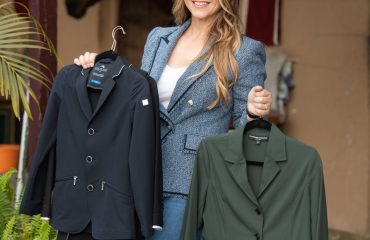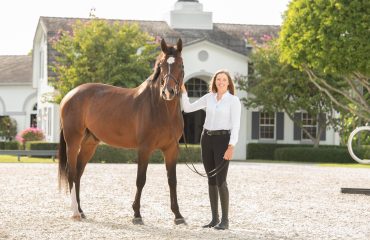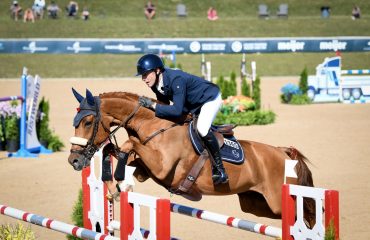
By Tafra Donberger
Portraits by Isabel J. Kurek
Armed with a little black bag and an iPad, Michele Hollis, M.D., is bringing medicine to the places equestrians need it most: barns, ring side, you name it, she can help where you’re at.
As a doctor who is an equestrian herself, Michele knows exactly how a horse person’s brain works. The early mornings, the late nights, putting the horse before yourself — she’s done it all herself, and it all began with a spunky horse named Sonny, short for ‘son of a…’
“I received him from an older cousin who had outgrown him after teaching him tricks such as drinking beer, eating dog food and running back to the barn,” Michele laughed. “I learned ‘emergency dismount’ before I learned to steer!”

Michele is a medical doctor and an equestrian.
Her mother wasn’t enthralled with Sonny, but Michele was able to convince her parents to purchase a different horse named Beauregard. “He couldn’t have been more ordinary,” she said. “He was wonderful, and I loved him.” Though she had no formal lessons as a child, watching Joe Fargis ride Touch Of Class to the gold at the 1984 Olympics inspired a pursuit of jumping.
It wasn’t until college, however, that Michele decided, unbeknownst to her parents, to choose what college she would attend based on whether there was an equestrian team or not. She chose Rhodes College in Memphis, Tennessee. “I structured my schedule so that I only went to class two days per week,” Michele explained. “This strategy left me five days to go to the barn as a working student.”
That’s where she met Holly Hugo-Vidal, who taught her the proper way to muck a stall, how to make a horse shine, set jumps and the other various chores associated with horses and the horse showing process. Michele finally had the opportunity to show horses, which she did with the Intercollegiate Horse Show Association (IHSA), starting with beginner walk-trot.
While she developed her skills as an equestrian, Michele developed her career by studying psychology. When she was a senior, someone recommended Michele go to med school instead of grad school. “Truthfully, in the beginning, medicine was just a job — until I discovered a way to connect it with my love of horses,” she said.
 Life-Changing Event
Life-Changing Event
Michele spent 10 years practicing medicine in various hospitals in her home of Virginia, but when her daughter, Rachel, was injured in a riding accident, there was a shift. “We have a friend who has racehorses, and Rachel had been breezing them,” Michele explained. “The saddle came loose and she came off at a fairly high speed.” Rachel suffered a spinal cord injury, which was what everyone was initially focused on. What they didn’t realize was Rachel had also suffered a concussion, which affected her cognitive abilities and emotions.

Michele with Talek, owned by Stephanie McComiskey.
Happily, Rachel is fully recovered, and Michele used that transformative experience to make a change in her way of practicing medicine. “As an emergency medicine physician, I’m trained to look at you and immediately determine if you’re sick or not sick, or if you have something that needs to be treated,” she explained. Off that premise, Michele began to see equestrians in private practice.
From January to March, Michele takes a form of sabbatical from her ER duties to live in Wellington, Florida, seeing patients on an as-needed basis. “Horse people don’t go to a doctor,” she said. “So if you can be where people are and meet them where their need is and do urgent care, I think that’s helpful.”
As the sole practitioner for Hollis Med, Michele is excited for the opportunity to do things that few other physicians do. Many of her clients come to her through word of mouth, and she gets to spend the time listening to them — both with a stethoscope and simply discussing symptoms and questions. And once she has an established relationship with a patient, she’s able to practice telemedicine, which allows her to discuss any concerns her patients have, no matter where, no matter when.
Most of what she’s called for are fairly simple diagnoses, with the occasional emergency that allows her to intervene and send a patient to a hospital for the care they need. Perhaps most importantly, she’s free to spend as much time with her patients as they need — a huge difference from the hurried physicians one might find in a busy hospital or family practice. “I love the idea that I have a role, like a braider has a role or the farrier has a role,” Michele said.

Michele and Talek in Wellington, Florida.
Equestrian Life
In the saddle, Michele competes in adult jumpers — or at least, when she finds the time. She and her kids, Rachel and Harold, live at their Perry Hill Farm in Virginia, along with her somewhat-retired Warmblood, Quito, and a retired short-stirrup pony, Major Fun.
As an equestrian herself, there’s nothing more satisfying than making that connection between her horse life and her professional one, so though she doesn’t get to ride as often as she wishes, she still feels connected. Michele brings her knowledge and skill to a world where she knows and understands that too often, an equestrian will ignore symptoms for as long as possible; yet she also knows that’s human nature, and by being available 24/7, she hopes to encourage her clients in receiving and maintaining care.

Michele talks to her daughter Rachel, on Talek, at the Winter Equestrian Festival.
“We need vets and farriers to take care of the horses,” she said. “Why not doctors to take care of the humans who support the horses? That’s as satisfying to me as it is for a trainer to take a young horse and make something nice of it.”
For more information, visit hollismed.com
Photos by Isabel J. Kurek













